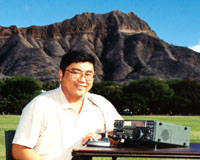 1296 MHz Mobile Communications
1296 MHz Mobile Communications
Mobiling at 1.2 GHz offers some unique advantages and challenges. Let's take a look at some of the details
Enjoy, and feel free to drop me an e-mail if you have any questions.
Simplex communications at 1296 MHz FM differs somewhat from regular two meter simplex operations.
Usually, for two meter simplex operations, one would try to use gain mobile antennas to get an advantage on the signal. Since a quarter wave is eighteen inches, a gain antenna tends to be longer than a quarter wave and eighteen inches. One has some flexibility in terms of mounting the antenna on a trunk lid, off to one side, and the results are reasonably good.
If you're travelling a lot in between valleys, a quarter wave antenna is preferrable. While it has less gain, it transmits higher in elevation. That additional component in the elevated direction can help you hear signals coming from above the valley walls and similarly, helps you to be heard if there is an available path.
In contrast, a quarter wave antenna on 1296 MHz is a little more than two inches. When mounted on the trunk lid, the roof has a substantial effect on the radiation pattern and can obscure contacts. Since the antennas are so small, you can use a gain antenna, such as the Diamond NR-124 which has 8.4 dB of gain and is only 28 inches long. When mounted on the trunk lid, it offers some visibility above the roof and helps you get out some of the signal.
Still, the roof impedes a good amount of the signal. It's best if you can run a mag mount antenna, and place the antenna in the middle of the roof. You'll enjoy the 8.4 dB of gain in all directions, with no obstruction from nearby features of your car.
Since the wavelengths are 1/8 the size on 1296 MHz, multipath and mobile picket fencing is less pronounced at normal driving speeds. It has the effect upon picket fencing as if you're driving eight times faster. The received signal would drop in and out faster than the AGC would react, and those brief moments you hear when the signal gets noisy and reemerges from the noise tends to go away. Imaging hearing normally picket fencing at 30 miles per hour, but having it disappear because it seems as if you're driving at 240 miles per hour!
On analog FM, you're more likely to encounter periods when signals can be heard or not heard, rather than hearing the telltale signs of picket fencing that clue you into the fact that you're about to lose a contact. As the gaps in silence increases or the fading noise of bacon sizzling increases, you'll know you're going to lose the signal shortly.
This is more annoying on digital voice using the Icom ID-1 radio, as you really can't tell the signal quality just by listening to the audio. Since it's hard to keep watching the S meter while you're keeping your eyes on the road, you're more likely to briefly hear the other station, then hear silence when the other station becomes out of range.
If you're mobile and the other station is fixed and running a gain antenna, you'll enjoy the greater opportunities at simplex operation. If there's buildings or other large structures that the fixed station can use to bounce the signal, it tends to give the effect as if he's operating a repeater on that building. That's especially true if the building is within two to three miles of his location.
The interference free nature of 1296 MHz mobile communications, the high antenna gain possible in small packages, and less picket fencing makes 1296 MHz mobile communications a refreshing change and challenge from two meter simplex operations. Why not be open to give it a try. You'll never see two meter simplex operations in the same way again.
Copyright © 1997-2015 Ron Hashiro
Updated: July 30, 2007 DISCLAIMER: Ron Hashiro Web Site is not responsible for the content at
any of the external sites that we link to and therefore
are not necessarily endorsed by us.
